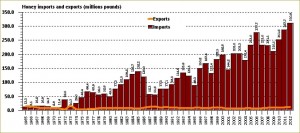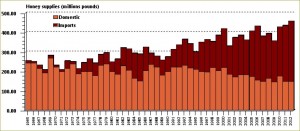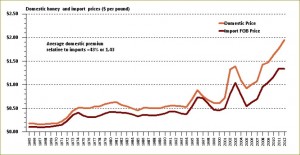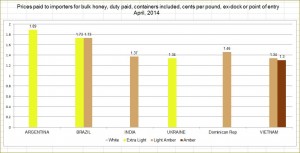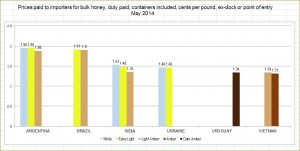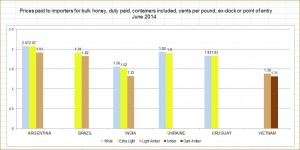Decline of domestic honey production
A year ago an article Honey Bees Are Dying said that Colony Collapse Disorder has wiped out whopping 10 million bee hives worth $2 billion over the past six years. The death rate for colonies has hit 30% annually in recent years and there are now about 2.5 million honey bee colonies left in the US, down from 6 million in 1947 and 3 million in 1990. That downward spiral leaves “virtually no cushion of bees for pollination,” the report’s authors write.
The below statistics has been taken from the US National Honey Board on Honey Demand, 2014 report. Colony collapse among U.S. suppliers and the growth of honey imports top the list of major structural changes in the US honey industry. In 1965, U.S. commercial honey bee colonies totaled 4,718 million colonies. By 2013, total colonies declined to 2, 64 million or about 53% of the 1965 levels.
Increase in honey import
From 1989 to 2000, Asia supplied 36.5% of the imported honey and South America, 40.7%. Major shifts after that period occurred with Asia’s share being 47.6% and South America’s equaling 31.3%, thus, pointing to the growing importance of Asia as a source of honey. Between the two periods, Asia’s volume grew by 135% and South America’s by 38%.
Combining domestic and imports provide a complete picture of available honey within the U.S. marketplace that must be utilized and marketed. Within the bars in figure below, the lower bars represent domestic production and the upper bars are imports. By 2012, total honey available to the U.S. marketplace reached 458 million pounds with imports accounting for approximately 68% of the total. That number is contrasted with 1965 when imports supplied around 5% of the total.
The above picture best illustrates the combined structural change in the honey industry. Total honey availability has increased by a factor of 1.79 times the 1965 pounds. Yet domestic honey accounted for around 32% of the total by 2012. Even with the U.S. colony collapse and productivity trends, total pounds of honey available to U.S. consumers has increased as a direct result of the growing imports of honey.
Domestic honey prices have risen from $0.18 per pound to over $1.95 per pound between the 1965 through 2012 years. That is nearly an 11-fold increase in price over the time span.
Latest price change trends
Let’s turn to some recent statistics. Honey production in 2013 from producers with five or more colonies totaled 149 million pounds, up 5 percent from 2012. The average producer price per pound was $2.121, up 6% from $1.992 in 2012
In the last eight years domestic honey prices in the US showed steadily growth in both retail (from ~$3.8 to more than $6 per pound, i.e. ~ 60% increase) and wholesale(from ~$2.7 to ~ $4.6 per pound. i.e. ~70% increase).
This year of 2014, with domestic production capable to satisfy only ~ 30% of the United States demand in honey 70% must be imported from abroad.
Accordingly, prices for honey import to the United States (although in general 50 – 60% lower than average domestic ones) expressed in CIF Incoterms have grown lately from ~ $1.50 to ~ $1.90 per pound, i.e. some 27% increase for the last three years.
Latest prices for US honey import
According to the USDA National Honey Reports, prices paid to the US importers that included transportation, custom duties and containers cost (ex-dock terms) in April 2014 fell into $1.30 (Vietnam) to $1.89 (Argentina) per pound range as shown below.
Prices for the US import in May 2014 were within $1.34 (Vietnam) to $1.95 (Argentina) per pound range:
Prices for the US import in June 2014 were within $1.31 (Vietnam) to $2.07 (Argentina) per pound range:
However, in June 2014 price for the US produced Buckwheat honey, for instance, was in the range of $2.50 to $3.15 per pound at ~ 4400 pound (2000 Kg) sale scale.
We will keep you posted on further trends in the US honey import prices.

